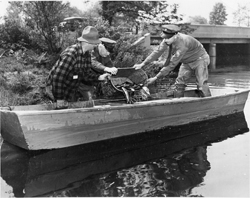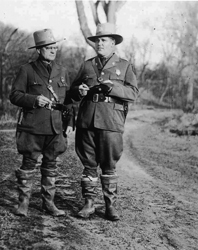150th Anniversary of the Connecticut Bureau of Natural Resources
Celebrating 150 Years Of Natural Resource Conservation in Connecticut

The DEEP’s Bureau of Natural Resources celebrated its 150th Anniversary in 2016. The Divisions of Wildlife, Inland Fisheries, Marine Fisheries, Forestry, and the Environmental Conservation (EnCon) Police all joined in the celebration, as well as many partners. Throughout 2016, we looked back at our history and also looked forward to the future of natural resources in our state. All six issues of Connecticut Wildlife Magazine in 2016 focused on the 150th Anniversary celebration, with many articles highlighting the history of the Bureau of Natural Resources.
View our historical timeline: Connecticut Bureau of Natural Resources Through the Years
View our Then and Now webpage: Select a topic and learn how the Bureau of Natural Resources and fish and wildlife in Connecticut have changed through time.
 Connecticut is rich with natural resources and a great diversity of habitat, landscapes, forests, fisheries, and wildlife. The colonists of the 1600s viewed the natural world as both an adversary and a provider. At that time, Connecticut’s natural resources seemed limitless. However, by the 1800s, Connecticut’s wilderness was gone and many fish and wildlife species had disappeared or were very low in numbers. Leaders realized action was needed to restore, manage, and conserve our natural resources.
Connecticut is rich with natural resources and a great diversity of habitat, landscapes, forests, fisheries, and wildlife. The colonists of the 1600s viewed the natural world as both an adversary and a provider. At that time, Connecticut’s natural resources seemed limitless. However, by the 1800s, Connecticut’s wilderness was gone and many fish and wildlife species had disappeared or were very low in numbers. Leaders realized action was needed to restore, manage, and conserve our natural resources.
Back in 1866, the Connecticut State Legislature took action and created the Fisheries Commission, starting us out on the path that led us to the science-based Bureau of Natural Resources of today. Over time, the original "commission" evolved and grew to encompass the Divisions of Wildlife, Inland Fisheries, Marine Fisheries, Forestry, and Environmental Conservation (EnCon) Police. The EnCon Police Division moved to the DEEP Bureau of Outdoor Recreation in 1996, but is part of the 150th celebration because its origin can be traced back to the original Board of Fisheries and Game.
 From the coastline of Long Island Sound, to the Litchfield Hills, the Connecticut River Valley, and the Eastern Highlands, the DEEP Bureau of Natural Resources, with the assistance of committed sportsmen and women, supportive legislators, and concerned citizens, has worked to protect and conserve the natural resources and scenic beauty that make Connecticut a special place to live, work, and visit.
From the coastline of Long Island Sound, to the Litchfield Hills, the Connecticut River Valley, and the Eastern Highlands, the DEEP Bureau of Natural Resources, with the assistance of committed sportsmen and women, supportive legislators, and concerned citizens, has worked to protect and conserve the natural resources and scenic beauty that make Connecticut a special place to live, work, and visit.
We are deeply indebted to William Myers, retired Conservation Officer, for the hundreds of hours invested by him to obtain, restore, and provide many of the historical photos (and their history) included in the 150th celebration materials.
Learn more about the divisions that celebrated 150 Years of Natural Resource Conservation in Connecticut in 2016:
Environmental Conservation Police
Historical Articles
Learn more about the history of the Bureau of Natural Resources
View the Centennial Edition of The Connecticut Wildlife Conservation Bulletin celebrating 100 years of environmental conservation law enforcement.
View the 125th anniversary issue of SCOPE published in 1991. SCOPE was the precursor to the current Connecticut Wildlife magazine.
Forty Years of Connecticut Wild Turkey Biologists from Connecticut Wildlife magazine.
In 1914, the last surviving passenger pigeon, named Martha, died at the Cincinnati Zoo putting an end to decades of greedy market hunting. View the article from Connecticut Wildlife magazine for more information on this incredible story.
Learn the history behind the Kensington State Fish Hatchery and the Burlington State Fish Hatchery in these Connecticut Wildlife magazine articles.
Looking Ahead
This milestone year also is an important time to look to the future. Adequate funding to perform various natural resource missions is critical. Will Connecticut's fish, wildlife, forests, and other natural resources survive for another 150 years? The answer is up to all of us.

Content last updated on February 20, 2020.


